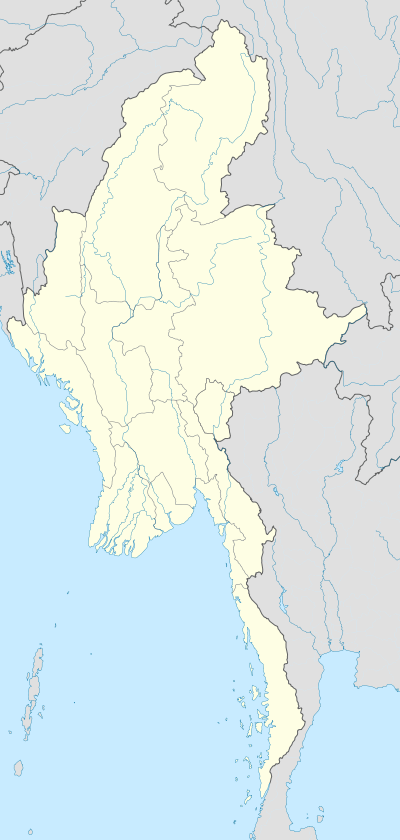Lewe Township
Lewe Township (Burmese: လယ်ဝေးမြို့နယ်) is one of eight townships of Naypyidaw Union Territory, Burma.[1]
Lewe Township လယ်ဝေးမြို့နယ် | |
|---|---|
Township | |
 Lewe Township | |
| Coordinates: 19°38′N 96°7′E | |
| Country | |
| Division | Naypyidaw Union Territory |
| Capital | Lewe |
| Time zone | UTC+6:30 (MMT) |
Demographics
2014
| Historical population | ||
|---|---|---|
| Year | Pop. | ±% |
| 2014 | 284,393 | — |
The 2014 Myanmar Census reported that Lewe Township had a population of 284,393.[2] The population density was 125.9 people per km².[2] The census reported that the median age was 25.7 years, and 94 males per 100 females.[2] There were 51,747 households; the mean household size was 4.3.[2]
Location and population
Lewe is one of the administrative township in Naypyidaw Union territory, Myanmar. It only far about ten miles distance of southwest from Pyinmana Township.It is not only laid on the way of Pyinmana -Kyaukpandaung Railway Road but also on Yangon-Mandalay Highway Road. As its focal point in trade network, bulk of local goods such as agricultural products flow are fast. Although Lewe Township was formerly part of Mandalay Division, it was designated as one of the original townships constituting the new capital region of Naypyidaw on 26 November 2008 by the Ministry Of Home Affair. According to official data of 2014 census, Lewe township has a population of 284,393.
Background history
At first, in Burma year of 191, it was because of "'Mg-Ngwet '" (မောင်နွဲ့ )founded Lewe on a small hill, called initially "Nga-Ngwet-Gone or Nga-Ngwe-Gone"(ငနွဲ့ကုန်း ခေါ် ငနွယ်ကုန်း), later became to "Wa-Ngwe-Gone". Name terms often change according to a change of era. The site of old town was located around at "Myoh-Gone Village" from southwest of new Lewe. Old town was about 1050 -feet long from east to west and wide about 840- feet from north to south. According to the expression of ancient historical records, it was known that each brick high-wall of the town was 15 feet high and a moat around the High-Wall was displayed.
"Min-Nagar(မင်းနဂါး) : King of Dragons" ruled " Wa-Ngwe-Gone" as Duke till Burma Year 191. In the beginning of year 202, when he reigned as King of Taung-Dwin-Gyi, he appointed to MP U Shwe-Lou as Duke of Wa-Ngwe-Gone. Such old town, Wa-Ngwe-Gone, was ruled by successive rulers.
Madam Khin-Oo, mother of Da-Bin-Shwe-Htee, who reigned in Kay-Tu-Ma-Ti, Taungoo in the beginning of the Burma year 892, was also a daughter of the Head of Wa-Ngwe-Gone Region. From the beginning of the year 1788 to nowaday, also called Lewe or Leiway.
Since the time of excavation to Sin-Own-Lake, agricultural sector such as rice cultivation improved widely in the whole region and rice mills, oil mills were established. As Lewe is a forest coverage region, timber production was well flourished before.
Urban area
Lewe Township consists of 7 Wards and composed by 60 villages and 261 Sub-village groups according to 2014 census data.
Borders
Lewe is bounded by Pyinmana Township in the east, Yedashe Township in south, Taungdwingyi Township in west, Dekkhinathiri and Pyinmana Township in the north, respectively. It length 47.02 miles from East to West, 18.64 miles long across North to South, and more than 872,248 square miles in area.
Geography, climate and vegetation
Lewe is located between mountains of Bago Yoma in the west and of Shan Yoma ranges in the east. There is no plain land in the region. Its minimum above sea level is 210 feet and maximum level in 2090 feet. Lewe is in monsoon climate region with maximum temperatures of 40 degrees Celsius and the minimum temperature is 22 degrees Celsius. Its current environmental conservation condition is covered by forest over 75 percent, one of the reserves is to protect the forest and the rest cover 68 percent. Vegetation in the region are valuable Timber, The Tip, cab, Sal Tree, Hardwood and other kinds of wood plants, and also found is a variety of bamboo.
Economy
Lewe,as part of NayPyiTaw Administrative body, its communication path is close and placed on the intersection to the main road transportation. Agricultural and Livestock products are mainly traded and the second business is services trade.
In the agricultural sector, there are farms, upland /lowland, branches, garden, pasture land. Mainly cultivating crops are corn, pulses, Oilseed, Industrial crops for raw materials. Orchards grow a variety of crops as well as other seasonal crops upon the market sector.
There are Township level 2-livestock zones in which bulk of chickens, pork, buffalo, cow, sheep, goats, quail, dairy cattle and fish. The shrimp farming industry, tourism, transaction services, industries, furniture industry, transport and other shopping stores are working in Lewe area.
Healthcare
Lewe is served by a public hospital: 100-bed Lewe General Hospital, 3 of circuit hospitals, 10 of Rural Healthcare Sub-divisions and 9 of private clinics.
Education
In educational infrastructure, 11 Basic Education High Schools,16 of Middle Schools, 226 primary schools, 9 Nursery Schools and 11 monastic schools. The literacy index od Lewe is 99.95.
Main Sights
- Phaung-Daw-Chat-Ma Pagoda
- Phaung Taw Oo Pagoda
- Yan Aung Myin Shwe Lett Hla Pagoda
- Sama Taung
- Yat-Kan-Zin Hill
References
- "Parliament Changes Names of Villages in Naypyitaw; Reconstitutes Townships". Mizzima online. 2011-09-05. Archived from the original on 2011-09-07. Retrieved 2011-09-07.
- "Lewe Township Report" (PDF). 2014 Myanmar Population and Housing Census. October 2017.
| Wikimedia Commons has media related to Lewe Township. |